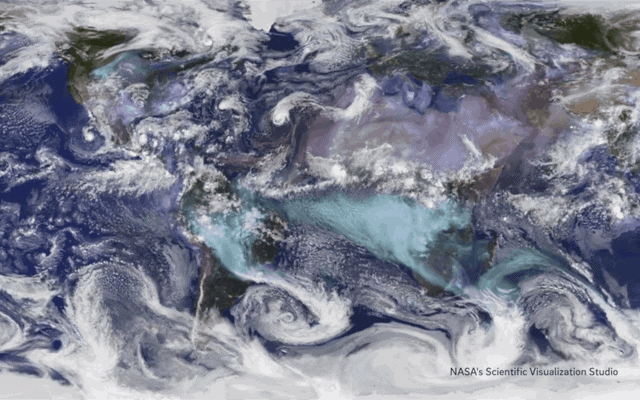Scientists at Scripps Institution of Oceanography at the University of California San Diego have received an award from the National Oceanographic and Atmospheric Administration (NOAA) to study low cloud “hot-spots,” one of the largest uncertainties in climate change models and predictions.
The project will be led by Scripps Oceanography climate scientists Nicholas Lutsko and Joel Norris as part of NOAA’s Modeling, Analysis, Predictions, and Projections (MAPP) Program. NOAA’s Office of Oceanic and Atmospheric Research (OAR) Climate Program Office (CPO) is supporting the Scripps-led MAPP project with around $410,000 in funding.
The Scripps team will focus on specific regions of the globe where the variability of clouds can tell us how sensitive Earth’s climate is to increased carbon dioxide concentrations. This “climate sensitivity” is generally defined as how much Earth’s global mean surface temperature would warm up if CO2 concentrations were doubled compared to pre-industrial levels.
A landmark report in 1979 concluded that Earth’s global climate sensitivity probably lies between 1.5 to 4.5°C (2.7 to 8.1°F) per doubling of atmospheric CO2. This means that if Earth’s atmospheric CO2 doubled from its pre-industrial level of 280 parts per million (ppm) to 560 ppm, we could expect that the global mean surface temperature would increase by between 1.5 to 4.5°C.
In the four decades following this finding, scientists have struggled to reduce this wide range of uncertainty. The first significant finding was published only recently in a report, co-authored by Norris, which found that the range of sensitivity likely falls between 2.6 and 3.9°C (4.9 to 7°F) of warming.
Now, the MAPP project led by Scripps aims to reduce this uncertainty even further by looking at specific geographic regions, which the team refers to as “hot-spots,” in which the variability of low cloudiness is indicative of climate models’ response to warming.
“I’m interested in trying to identify these hot spots, which are the most important regions in terms of the relationship between clouds and climate sensitivity,” said Lutsko, an assistant professor at Scripps and principal investigator of the MAPP project. “The idea is to find ways in which clouds change in the current climate, which can tell us something about how they’ll change in the future.”
To tease apart the relationship between low clouds and climate, a team of Scripps and NOAA researchers will combine satellite data and observations with climate model simulations, including some developed at NOAA’s Geophysical Fluid Dynamics Laboratory. These tools will help researchers evaluate how well the models represent low-level clouds and their governing meteorological conditions over the global ocean, particularly in hot-spots.
“Low-altitude cloud regions are a key source of uncertainty for how the Earth’s climate will respond to increases in greenhouse gases. Dr. Lutsko’s project promises to improve understanding of what’s going on in those regions,” said Dan Barrie, program manager of the NOAA MAPP Program. “Moreover, Dr. Lutsko’s close collaboration with NOAA’s Geophysical Fluid Dynamics Laboratory will directly advance our Agency’s modeling efforts.”
Lutsko said this project will delve into existing data and climate models of the El Niño-Southern Oscillation (ENSO) cycle, a recurring climate pattern involving changes in the temperature of waters in the central and eastern tropical Pacific Ocean. These cycles can produce extreme warming and cooling events known as El Niño and La Niña, respectively, as well as huge changes in clouds.
This study will focus on hot-spots during previous ENSO cycles, in which clouds might be particularly important for predicting climate change. These hot-spots are all located in the subtropical ocean, including off the coast of San Diego.
Climate models that show a larger change in clouds during the ENSO cycle tend to have a higher climate sensitivity, so better understanding this relationship is key to reducing the range of uncertainty, said Lutsko.
The MAPP project will also harness Norris’ expertise in using satellite data to look at the ways different types of clouds have different impacts on Earth’s radiation budget.
“Clouds have a huge leverage on climate because they have such large radiative impacts,” said Norris, a professor at Scripps and co-principal investigator of the MAPP project. “Small cloud changes can have as much impact as a doubling of CO2. We’re trying to understand what will happen to clouds as the earth gets warmer—will there be more clouds or fewer clouds and what type?”
If there are more clouds to reflect solar radiation, that would produce more of a cooling effect, explained Norris, because there wouldn’t be as much solar radiation absorbed by the earth. If the clouds’ greenhouse effect weakened, that would also produce a cooling effect.
However, if there’s a reduction in clouds, then more solar radiation would be absorbed by the earth, producing a warming effect, and it looks like this may be happening over a large part of the ocean, said Norris. He expects the cloud greenhouse effect to get stronger over time because clouds will rise higher in the atmosphere with global warming.
This research builds upon that of Veerabhadran Ramanthan, a Scripps climate scientist who was among the first to use satellite data to measure the effects that clouds have on climate. His groundbreaking study on Earth’s radiation budget was published in 1989.
More broadly, this project will help NOAA prepare for the potential impacts from increased atmospheric CO2 concentrations by reducing uncertainty in Earth’s climate sensitivity and by improving the models used by NOAA to forecast future climate states.
The proposal was submitted as part of the competitive MAPP Program, which is housed within the Earth System Science and Modeling (ESSM) division of NOAA. This program solicits research investigations to constrain climate model sensitivity focusing on clouds, convection and aerosol processes and their role within the coupled Earth system, with the goal of reducing overall uncertainties in future climate projections.

